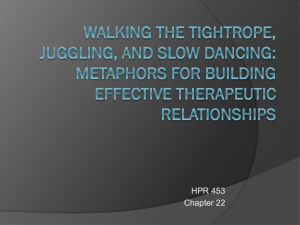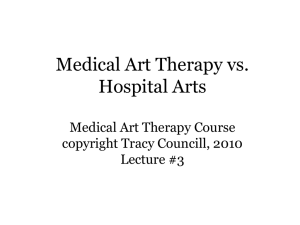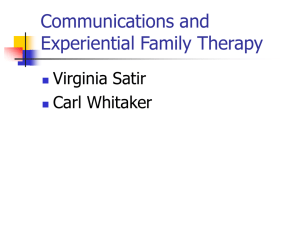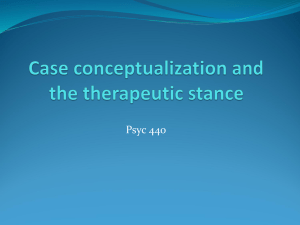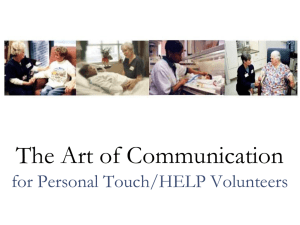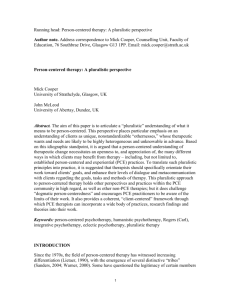Is_Resistance_Dead_-_WebSite
advertisement
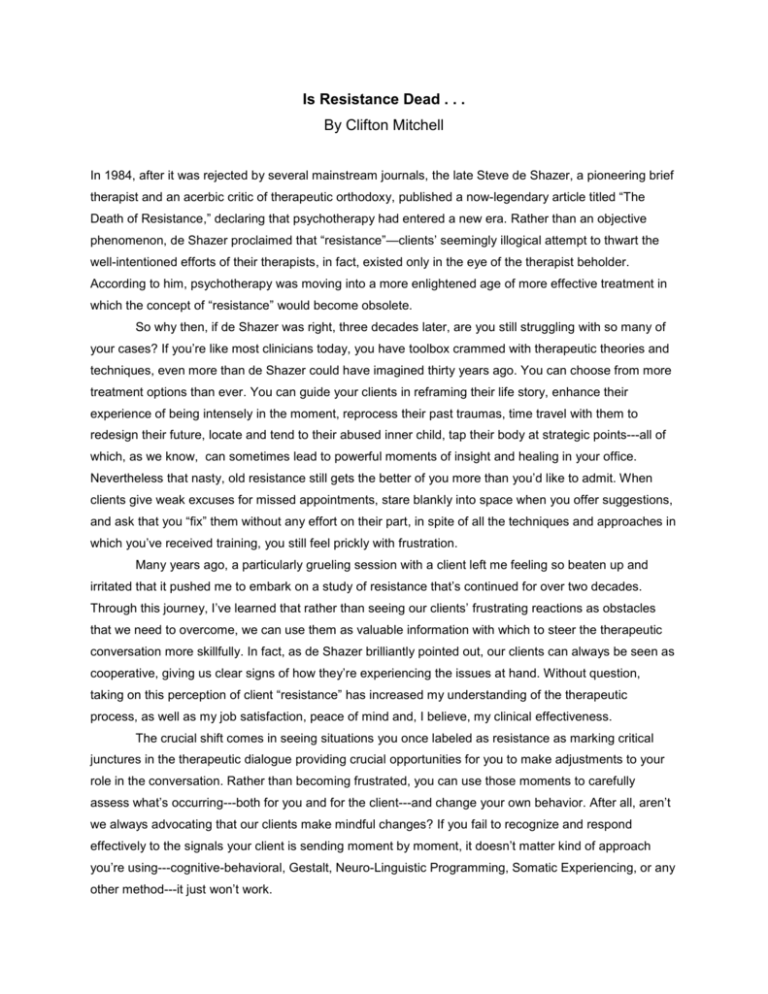
Is Resistance Dead . . . By Clifton Mitchell In 1984, after it was rejected by several mainstream journals, the late Steve de Shazer, a pioneering brief therapist and an acerbic critic of therapeutic orthodoxy, published a now-legendary article titled “The Death of Resistance,” declaring that psychotherapy had entered a new era. Rather than an objective phenomenon, de Shazer proclaimed that “resistance”—clients’ seemingly illogical attempt to thwart the well-intentioned efforts of their therapists, in fact, existed only in the eye of the therapist beholder. According to him, psychotherapy was moving into a more enlightened age of more effective treatment in which the concept of “resistance” would become obsolete. So why then, if de Shazer was right, three decades later, are you still struggling with so many of your cases? If you’re like most clinicians today, you have toolbox crammed with therapeutic theories and techniques, even more than de Shazer could have imagined thirty years ago. You can choose from more treatment options than ever. You can guide your clients in reframing their life story, enhance their experience of being intensely in the moment, reprocess their past traumas, time travel with them to redesign their future, locate and tend to their abused inner child, tap their body at strategic points---all of which, as we know, can sometimes lead to powerful moments of insight and healing in your office. Nevertheless that nasty, old resistance still gets the better of you more than you’d like to admit. When clients give weak excuses for missed appointments, stare blankly into space when you offer suggestions, and ask that you “fix” them without any effort on their part, in spite of all the techniques and approaches in which you’ve received training, you still feel prickly with frustration. Many years ago, a particularly grueling session with a client left me feeling so beaten up and irritated that it pushed me to embark on a study of resistance that’s continued for over two decades. Through this journey, I’ve learned that rather than seeing our clients’ frustrating reactions as obstacles that we need to overcome, we can use them as valuable information with which to steer the therapeutic conversation more skillfully. In fact, as de Shazer brilliantly pointed out, our clients can always be seen as cooperative, giving us clear signs of how they’re experiencing the issues at hand. Without question, taking on this perception of client “resistance” has increased my understanding of the therapeutic process, as well as my job satisfaction, peace of mind and, I believe, my clinical effectiveness. The crucial shift comes in seeing situations you once labeled as resistance as marking critical junctures in the therapeutic dialogue providing crucial opportunities for you to make adjustments to your role in the conversation. Rather than becoming frustrated, you can use those moments to carefully assess what’s occurring---both for you and for the client---and change your own behavior. After all, aren’t we always advocating that our clients make mindful changes? If you fail to recognize and respond effectively to the signals your client is sending moment by moment, it doesn’t matter kind of approach you’re using---cognitive-behavioral, Gestalt, Neuro-Linguistic Programming, Somatic Experiencing, or any other method---it just won’t work. A Brief History of Resistance Along with so much else that has shaped the development of psychotherapy, Sigmund Freud was the originator of the concept of resistance. Of course, given the challenging perspective he was offering clients about, among other things, their unconscious desires to have sex with their parents, I assume he must have regularly felt compelled to account for his patients’ reluctance to accept his theories. He wound up defining what he labeled “resistance’ as the client’s attempts to avoid anxiety-provoking, psychologically threatening information. In Freud’s view, if the client wasn’t “buying” what he was “selling,” the client was being resistant. Resistance was something in the client and for much of psychotherapy’s history, therapists were not encouraged to look at their own contributions to the problem. Fortunately, by the mid-20th century, several figures rose to prominence within the field who challenged this prevailing view and new perspectives began to evolve. In 1951 humanistic pioneer Carl Rogers stated in Client Centered Therapy that “Resistance to counseling and to the counselor is not an inevitable part of psychotherapy, nor a desirable part, but it grows primarily out of poor techniques of handling the client’s expression of his problems and feelings . . . out of unwise attempts on the part of the counselor to short-cut the therapeutic process by bringing into discussion emotionalized attitudes which the client is not yet ready to face.” With this, Rogers placed the problem squarely on therapists: if they move too far ahead of the client too quickly, they’re sure to evoke resistance. As an example of the flawed technique Rogers refers to, I once told a client too early in the process that she appeared to be quite angry with her parents---an emotion that wasn’t readily accepted since her conservative, religious upbringing had taught that she “honor” her parents. Should her subsequent reluctance to accept her anger toward her parents be considered resistance or a result of my premature remark about something she wasn’t yet ready to embrace? Around the same time that Rogers was making his groundbreaking contributions, hypnotherapist Milton Erickson took the evolution of our perspective on resistance even further. Fascinated with the influence of language, Erickson pointed out that the specific words and phrases the therapist used contributed both to client resistance and to its management. Similar to Rogers, he viewed a therapist’s dialogue as a part of the resistance equation. For example, I could tell a client that, in certain situations she reacts “faint-heartedly” or I could say that she’s “searching for the courage to express her desires.” The first phrase might make her feel belittled and arouse defensiveness, whereas the second might seed a new idea and promote movement. In 1973, psychologists Stanley Strong and Ronald Matross added another layer to the concept of resistance by describing resistance as the “psychological forces aroused in the client that restrain acceptance of influence (acceptance of the counselor's suggestions) and are generated by the way the suggestions are stated and by the characteristics of the counselor stating them.” Thus their view of resistance introduced the added implication that it’s spawned not only by the precise words you choose, but also by how you choose to say them. Nevertheless, many current therapeutic methods still view resistance as residing within the client. For example, cognitive therapists see it as resulting from clients’ distorted thinking. From a behavioral perspective, resistance results when the client is reinforced by the wrong thing, a concept once referred to as “secondary gain.” Despite all the advances that have been made in so many areas of psychotherapy theory and practice, too little attention is still given to the idea that clients’ “resistant” behaviors are just natural reactions to difficult situations, and should be seen as useful forms of communication. Common Patterns of Resistance Imagine that client that many have seen often--the mother who comes to your office depressed and stressed over family issues that include a complacent husband, a withdrawn daughter, and most importantly, an alcoholic son still living at home at the center of the family conflicts. As you sort out the family system, you immediately begin to see a pattern of enabling behavior from the mother that includes providing her son money that is spent on alcohol, replacing wrecked vehicles, covering up and apologizing for his behavior and, of course, bailing him out of jail while arranging another second chance. You listen, you empathize, you convey unconditional positive regard. The issues she presents sound similar to those of many other clients you’ve seen over the years. All the common patterns of rescuing, inappropriate reinforcement, and a lack of tough love are present in your client’s enabling the son’s alcoholism. You feel you have something valuable and helpful to offer and you’re ready to move forward into the next stage of treatment. So once you’re satisfied you’ve established initial rapport, you take the next step and offer what you consider some sensible feedback about the client’s situation, delicately pointing out a few flaws in her way of handling the families’ problems and supportively explaining how, despite her good intentions, her actions are helping to maintain the problems she’s there to address. Basically, you do your thing . . . and the client listens, nods agreeably, but seems somehow unimpressed with the value of what you’re offering. Your suggestions are met with blank stares as she goes into momentary states of trance. When not leaving the room mentally, she replies with a host of “Yes, but…” responses that are formed around themes (i.e., cognitive distortions) regarding her role as a mother and the need to be supportive. You offer some homework and give a few suggestions, but when the client returns for the next appointment, nothing has changed at home. You give some more homework, engage in more supportive dialogue, grow even more empathic , but the harder you work, the more it feels like you’re sinking even deeper into the mud. Week after week, there’s only polite attention to the suggestions and explanations your provide and no sign of anything changing. Maybe You become frustrated and think, Why did she come here in the first place if she doesn’t want to try something---anything---different! Still you’re certain that you’re trying your best and following the appropriate treatment protocol faithfully. In your mind, the problem is clear—you have a very “resistant” client on your hands. Finally, your patience exhausted, you decide to pull out the big guns and deliver a blunt confrontation that you’re sure will jar her out of her denial. You aggressively expound that her actions are maintaining the problems and that she must radically change her approach if she wants any peace while noting that she is deceiving in presenting a desire to change. You wait for the walls to come tumbling down, but nothing happens. The enabling of the son’s alcoholism continues, and every session feels like you have to start over, redundantly explaining the promising alternatives she might try to the various dead-end coping strategies she’s currently employing. How can this client not respond to the compelling logic of your approach? Her life isn’t working and you’re offering a promising set of new possibilities, carefully and thoughtfully pointing out behaviors she needs to change and the cognitive distortions she needs to challenge. You’re running out of things to try, but it’s not your fault. After all, you can’t help people who just aren’t ready to change. But what might be called “modern resistance theory,” offers you a way to pull back from your sense of being helplessly stuck to get a fuller picture of how you got there. Actually, the stagnation in the therapeutic relationship started the moment you began delivering information in a manner that your client wasn’t ready to accept. In reaction, she then began trying to subvert your influence and then in response to her reluctance, you pushed even harder---in this case, resorting to blunt confrontation. So she pushed back even more, missing appointments, fiddling with her phone in sessions, giving you “yes, but . . .” responses to all your sage and helpful suggestions. Your frustration to her “resistance” increased and, basically, your reactions and those of your client became a vicious cycle, fueled by your escalating attempts not to be influenced by each other. This is, of course, a common pattern in therapeutic stalemates. The key to finding alternative ways to proceed is to scale back your own expectations and sense of what is possible at this stage of the therapy process. What you initially failed to recognize is that the client was only at the point where she would accept influence in subtle forms of communication---an indirect suggestion perhaps, certainly not a blunt confrontation. Rather than honoring, embracing, and micro-stepping from the client’s current state, you made the most common of therapeutic mistakes--you got ahead of the client. Your approach didn’t mesh with her psychological state at that moment regarding the problems in her life. The harder you tried to help her, the more disconnected from her you became. Resistance? But who exactly was being resistant, the closed-off party failing to recognize that something needed to change or you in failing to recognize the therapeutic disconnect that was occurring? Developing a Deeper Understanding Perhaps the most important thing to recognize about the phenomenon we refer to as “resistance” is that it is always a circular pattern of interaction. As clinical psychologist and addictions expert William Miller and Stephen Rollnick reminded us in Motivational Interviewing: Preparing People for Change, “Resistance is something that occurs only within the context of a relationship or a system.” As therapists, clearly we’re always prime components in the resistance equation: we push too hard, the client pushes back, and putting the “resistance” label on the client usually only further interferes with the possibilities for doing something different. So what do you do when you reach those stuck points with clients, when they simply won’t embrace your ideas? In most cases, the most immediate and practical answer is: stop pushing. Don’t create more resistance as the client pushes back against your suggestions and ideas. Move to a position that provides clients nothing to push back against. How can they be resistant if you give them nothing to resist? When managing the “resistant” client, it’s always helpful to keep in mind the well-worn but still useful joke--Question: How many therapists does it take to change a light bulb? Answer: One, but the light bulb has to really want to change. You can’t make people change, but if you’re a good therapist, you can inspire them to want to change. We’re constantly reminding clients, “You can’t change other people, you can only change yourself.” How ironic, therefore, that we’re typically trained to develop a treatment plan and enter sessions with the intention of changing clients! How much frustration and wasted effort we might spare ourselves and our clients if instead of working to change them, we would focus on our own contribution to the creation of “resistance.” The Expert Trap How do we know when a critical juncture in therapy is taking place? The signs are usually quite apparent—albeit frustrating for us as agents of change: silence, hostile challenges, passivity, or the alltoo familiar “yes, but . . .” response. Suppose a client comes to you with a large array of problems to which you immediately see solutions. As you learn more about the client, you become increasingly certain that your ideas can help him, and repeatedly offer advice and suggestions. But here’s the catch: the more of an expert you become, the more you provide him with something to resist. Your expert suggestions aren’t welcomed at this point—his “yes, but…” responses are signals of this actuality, if only you are willing to recognize that. So what do you do? How do you honor your client’s “yes, but . . .” with understanding and acceptance? One of the most effective ways of getting out of the expert trap is reversing your know-it-all therapeutic posture and presenting yourself as less knowledgeable, naive, and puzzled, a co-investigator of how to get him unstuck from his current quagmire. Now there is nothing to resist. Although your attachment to remaining the knowledgeable professional can make your reversal difficult, particularly if you really think your ideas would help, it’s important to realize that the more of an expert you become, the less psychological freedom your client has to explore possibilities on his own and experience a sense of agency in his own life. This expert trap is often fueled by our dedication to being helpful and our frustration with clients’ refusal to accept our influence. But our good intentions and how much we know isn’t what matters; nor is how much we want to help. What matters is what’s occurring in our relationship with a client at any given moment. Of course, if your client is accepting of your suggestions, don’t resist his openness by holding back what you have to offer. A good rule of thumb is, the more resistant the client, the less you know; the more motivated the client, the more you know. An Alternative Perspective The broad area of academic study that best captures the perspective being described here is called Social Interaction Theory and has emerged over the last decades incorporating the ideas of Rogers, Erickson, de Shazer and many other contributors. It posits that whenever two people are interacting, including the therapeutic conversation, there’s always an exchange of influence that creates the dynamics of the relationship. From this perspective, clients can be seen as coming into therapy to receive some form of influence that’ll help them resolve their problems. In my trainings I teach that “resistance” is created by the therapist when the method of delivering influence is mismatched with the client’s current propensity to accept the manner in which the influence is delivered. While that may sound a bit longwinded, it helps us clearly identify the reason for resistance in the therapy room, and encourages us to pinpoint the moment it enters into the therapeutic dialogue. In fact, a close review of a clinical session almost always reveals that a therapist’s statements have spurred a client’s resistance without having to resort to any arcane theorizing about hidden, intrapsychic processes. But beyond that, Social Interaction Theory suggests a core set of practical guidelines that can help us respond more quickly and effectively when the tell-tale signs of “resistance” appear in our offices. Slow the Pace. When they encounter resistance, many therapists unconsciously increase the pace of the dialogue in an effort to break through the current struggle, but that’s almost always a mistake. It’s usually better to space out your words more and allow for moments of silence. This technique results in a distinctive therapeutic environment that has several immediate benefits. First, it creates pressure on the client to fill the space you’ve opened. Second, it provides time for thoughts and feelings to emerge—two things “resistant” clients avoid. The internal psychological work done by clients occurs in the moments between the spoken words. When you slow the pace, you provide more time for clients to process what’s being said, increasing the opportunity for a disruption of their current patterns of thinking and perceiving. Third, slowing the pace creates an environment in which the therapeutic tension around the problem at hand remains within the client. Many times, in a misplaced effort to help, therapists begin taking ownership of clients’ problems, relieving the client of dealing with the tension the problem creates and placing it between the client and therapist. Remember the last time you were in an argument? The faster and louder you presented your points, the greater the tension became between you and the other person. In therapy, when you slow the pace, you can keep the struggle within the client, where it belongs. Seek Details. People say that the devil is in the details, but so is the way out of most therapeutic stalemates. Take a moment and look back on any case in which you were particularly successful. Chances are what made the difference weren’t just general insights about life but more fine-grained shifts in the clients’ way of approaching the challenges in their life. Much of what’s labeled resistance is the result of a therapist’s failure to move the conversation from broad strokes to specifics. I once had a suicidal client who was alarmingly close to killing himself. Although he was divorced, unemployed, and alcohol addicted, all of which could be motivators for suicide, it turned out none of these was the driving force behind his suicidal tendencies. After a detail-seeking discussion in an emergency session, he revealed that he’d been told as a child that bouncing his baby brother on his knee had caused his brother’s autism. Overwhelmed with pain and guilt, my client had never revealed this information to anyone. After we discussed why there was no link between bouncing a baby and autism, he began wanting to live again. Had I assumed the typical motivators for suicide needed to be the focus, I likely would have experience continued “resistance” to living from the client, but that resistance would only have been my failure to ascertain this client’s true concerns and motivations. Find the Emotionally Compelling Reasons for Change. Too often therapists give too much importance to the role of reason and logic in the early stages of the change process. In fact, most people aren’t motivated to change by logic; they only change when they have emotionally compelling reasons to do so. If people changed because of logic, no one would smoke, no one would drink, and no one would overeat. We waste a lot of therapeutic time on logical reasoning that’s met with rebuttals mislabeled as resistance. So if you want to break through resistance, uncover the client’s emotional motivators. The best tool for discovering clients’ emotionally compelling reasons for change is to deliver wellphrased, high-level, empathic statements that label their emotions and bring them into greater awareness. This tool should be used consistently during the quest for the details of a situation. As you bring forward clients’ emotions, monitor their reactions in a search for what will trigger strong incentives and motivations. I once heard about a dependent female client in treatment for addiction whose therapist kept encouraging her to make changes for herself, not for those around her. When she suddenly began making significant improvements in her life, however, she said she was making them for God, not for herself. Her therapist was troubled by this statement, interpreting it as displaying dependency. He tried to disrupt this motivator and promote more self-focused reasons for change, failing to accept that her emotionally compelling reason might not meet his preconceived ideal. Who was being resistant in this case? When dealing with resistance, don’t fight the client’s motivators when they’re working! Establish Mutually Agreed Upon Goals. A prime component of a therapeutic relationship in which resistance is kept to a minimum is the establishment of mutually agreed upon goals that both you and your client can state clearly. There are two tiers to these goals. The first tier is mutual agreement on what the overall goal of therapy is. What would constitute a successful outcome? The second tier is mutual task agreement, which is best characterized as agreement on the goal of the immediate conversation at hand. Combining these two tiers, a good therapist will constantly consider the client’s perception of what’s being discussed at the moment—i.e., whether it feels like something worthy of discussion from the client’s perspective. So how do you uncover goals to agree on? Rather than finding them in a packaged treatment plan program, seek goals that emerge from conversations with the client, especially clarifying why the presenting problems are problems from the client’s perspective. To do this, direct the client with a statement such as, “Tell me how this is a problem for you.” I have yet to meet a human being who would not get absorbed in the task of describing exactly why his/her problems were problems for him/her. As you listen, it can be very helpful to focus on both what the client wants and what he does not want. Clarifying what is the opposite of the undesired is a useful way of cultivating goals based on client’s perceived needs and giving therapy concrete direction. The bottom line in our profession is that we cannot change people; we can only aid people in creating the changes they desire. Therapists who impose goals on clients are like salespersons who try to sell products that people do not want. Recall the last telemarketer that called trying to sell a product for which you have no desire and you will get a feel for the clients’ experience when we impose goals. Nevertheless, while most mental health professionals abhor sales work, we often allow ourselves to move into a position of selling treatment plans to clients who have no desire to buy—this is a surefire way to manufacture “resistant” clients. As mental health issues have moved more to the forefront of our culture, there has been an increase in referrals to us by courts, schools, and families as a means to change socially unacceptable behavior. We have shifted from an I-have-a-problem-for-which-I-need-help to a we-are-sending-thesepeople-to-you-please-fix-them perception of the therapeutic process. The perception that we somehow have the ability to “fix” people has gone largely unchallenged by the mental health community. To this end, we have taken on the responsibility of setting goals for clients that the world assumes are feasible rather than sorting out clients’ goals for themselves. Whenever goals are imposed on clients by outside agencies that are not mutual, “resistance” is inevitably provoked. Radical Change After a 100 years of the existence of this profession, it’s finally time to reexamine both the possibilities and the limits of psychotherapy and the concept of resistance is central to that reexamination. Like so many other people in this field, I have spent countless hours going workshops and lectures trying to learn ever more powerful techniques for producing change. But no matter how seemingly powerful the methods I learned, I wound up regularly experiencing “resistance” from my clients again and again. It is only more recently, as I’ve grown more aware of how much that resistance was created by me, that my experience as a psychotherapist has undergone a fundamental transformation. I now see my primary job as not trying to change my clients, but to keep increasing my understanding of their world, always monitoring our exchanges to make sure I stay in sync with where they are and where they want to go, noticing when, for whatever reason, I begin to create more of what I formerly labeled resistance. When I detect a client’s reluctance to go along with my perceptions, I immediately notice what isn’t working and focus on slowing the pace, getting more details, and discussing how the conversation can better serve the stated goals of the session until the client and I are once again on common ground. To be sure, the path towards helping clients achieve meaningful goals in our work together can often be indirect. At times, it can seem as if I’m journeying to the East to reach the West, but I feel that my clients and I are closer partners in the process without my being regularly distracted by the intrusive presence of my old companion “resistance,” who rarely visits my office these days. Clifton Mitchell, Ph.D., is the author of Effective Techniques for Dealing with Highly Resistant Clients. He’s created The Legal and Ethical Game Show Challenge, the only legal and ethical training utilizing a game-show format. He’s a Teacher of the Year recipient at East Tennessee State University. Contact: cliftmitch@comcast.net; website: www.cliftonmitchell.com. Tell us what you think about this article by e-mail at letters@psychnetworker.org, or at www.psychotherapynetworker.org. Log in and you'll find the comment section on every page of the online Magazine.


